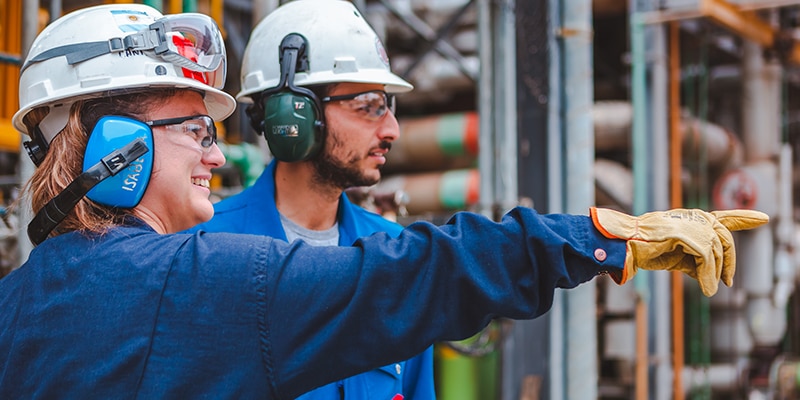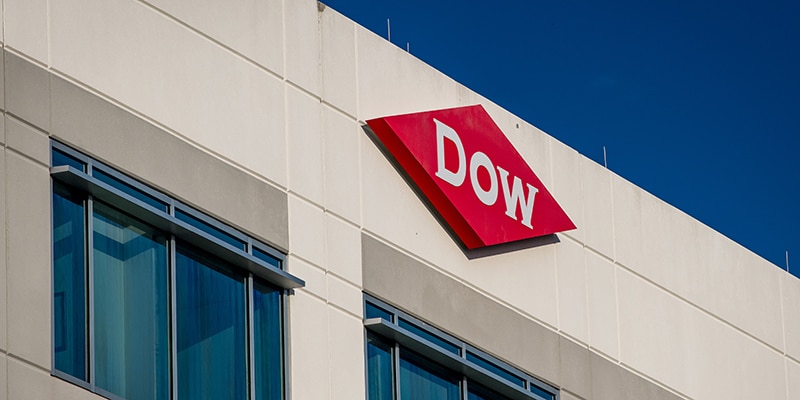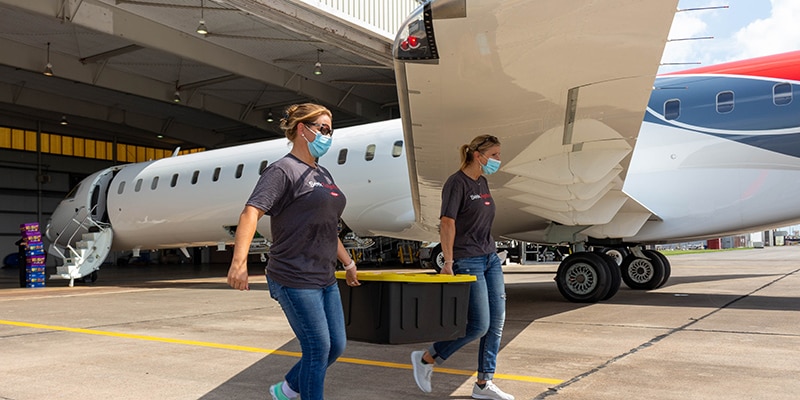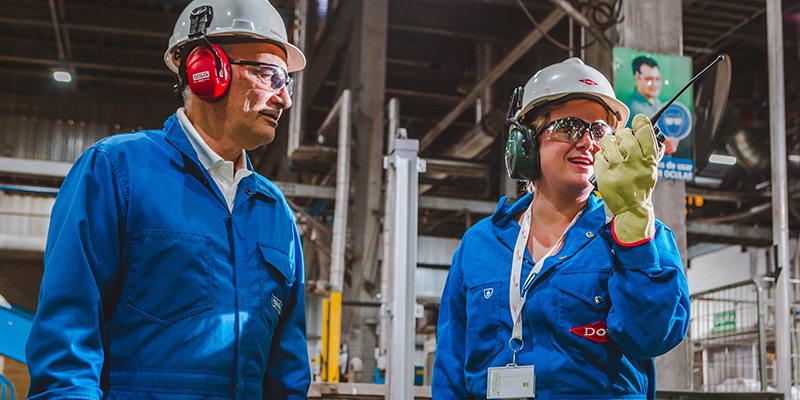Our sustainability journey keeps evolving as we get close to reaching our 2025 Sustainability Goals. By collaborating with like-minded partners, we can envision a stronger future together through a more sustainable planet and society.
2025 Sustainability Goals

See the results of our ambition in action
Leading the blueprint
Dow will develop societal blueprints that integrate public policy solutions, science and technology, and value chain innovation to facilitate the transition to a sustainable planet and society.
Our key metrics
- Developing a pipeline of blueprints in which Dow can make an impact
- Creating a metric to evaluate our impact in fostering more collaborative action toward a more sustainable planet
- Monitoring and updating our blueprints to reflect ongoing conversations
Milestones
- Published four blueprints including Unlocking Carbon Reductions (2018), Sustainable Watershed Management (2018), Product Safety (2021) and Valuing Nature (2021).
- Partnered with the Keystone Policy Center to produce a toolkit and training course that equips employees to develop and launch blueprints. Explore the Blueprint Thinking Toolkit for Collaborative Action.
Advancing a circular economy
Through innovation and collaboration, Dow will help facilitate the world’s transition to a circular economy, where waste is designed into new services and products.
Our key metrics
Dow will collaborate to implement six major projects that deliver solutions and advance the circular economy.
Milestones
- All six major projects were implemented, including our collaborations with Mura Technology on Europe’s largest chemical recycling footprint, Valoregen to build the largest hybrid recycling facility, SILASTIC™ SST-2650 Self-Sealing Silicone alongside Bridgestone, and REVOLOOP™ Recycled Plastics Resins alongside many partners around the world.
Delivering breakthrough innovations
Dow delivers breakthrough sustainable chemistry innovations that advance the well-being of humanity and have a net-positive impact.
Our metrics
- Increase the net-positive impact of products across all markets such that the benefit to global sustainable development exceeds burdens.
- Transition the Sustainable Chemistry Index (SCI) to the Dow Innovation Portfolio Sustainability Assessment.
- Dow businesses set their own business-specific sustainability goals and track progress.
- >85% of Dow's innovation portfolio is aligned to sustainability outcomes.
Milestones
- Achieved goal ahead of schedule by significantly increasing the net-positive impact of our product portfolio and integrating portfolio assessments and business-specific sustainability goals across Dow.
- Our businesses have transitioned from using the Sustainable Chemistry Index developed by Dow to track our goal progress to the Dow Innovation Portfolio Sustainability Assessment, which is a science-based, future-oriented and customer-centric tool that helps us assess our product portfolio and embed sustainability in our key business decisions.
- In addition, our businesses now set their own business-specific sustainability goals and track progress on outcomes.
- Dow aligned >89% of innovation portfolio to sustainability outcomes.
- Record-setting twelve Edison awards were earned in 2024.
Valuing nature
Dow applies business decision processes to complete projects that increase business value and are better for ecosystems.
Our metrics
- By 2025, Dow will deliver $1 billion in NPV through business-driven projects that enhance nature.
- By 2020, Dow will screen all capital and real estate project, business development and new products for potential benefit and impacts.
Milestones
- Achieved goal in 2023, following the realization of $1.2 billion in net present value (NPV) from business-driven projects that enhance nature.
- In 2021, achieved target to screen 100% of capital projects for potential benefits and impacts to nature, water, air, soil, land use and opportunities to utilize engineered natural technology.
Safe materials for a sustainable planet
Dow will innovate sustainable materials of tomorrow, lead candid conversations about product safety and commit to the advancement of open and transparent chemistry.
Our metrics
Sustainable materials of tomorrow
- Developing an Internal Sustainable Materials Strategy to help guide innovation
- Implementing 10 sustainable alternatives
Leading a candid conversation
- Defining and maintaining Dow’s product safety story
- Developing five collaborations to advance the conversation on product safety
- Developing and implementing Product Stewardship Academies in emerging regions
Providing unprecedented transparency
- Advancing transparency beyond regulatory-driven Safety Data Sheets for all Dow products
Milestones
- We are at 100% complete across all key metrics.
- Finished development of our priority chemistry strategy and introduced our tenth and final sustainable alternative.
- Met our commitment to participate in five collaborations to advance conversations on product safety, including the launch of a framework for chemical safety assessment incorporating new approach methodologies within REACH and our collaboration with Beyond Benign to create the first Green Chemistry Education Challenge Awards.
- A product safety blueprint was created to demonstrate the value of chemistry and material science to society and outline Dow’s approach to developing products that are safe for their intended use. View the Product Safety Blueprint Launch.
Engaging for impact: communities, employees, customers
Dow employees will apply their passion and expertise to advance the wellbeing of people and the planet.
Our metrics
- Improve employee experience through volunteerism across Team Dow.
- Invest in programs and partnerships that positively impact people, communities and the environment.
Recent highlights
- In 2023, 75% of employees reported volunteering. A strong connection has been found between employees who volunteered or participate in Employee Resource Groups (ERG) and those who reported a positive employee experience.
- In 2021, as part of the Company’s enhanced Total Rewards program, Dow launched its Global Volunteer and ERG Participation Policy, which grants employees 12 hours of paid time-off to volunteer and engage in ERG activities.
- Our #PullingOurWeight program engages Team Dow to take action against waste in the environment while encouraging employee volunteerism, business partnerships and community connections. In the six years since Dow launched our #PullingOurWeight campaign, tens of thousands of colleagues, family members and stakeholder volunteers have collected more than 2.1 million pounds of waste from waterways and watersheds to neighborhoods as part of the largest single-cause volunteer effort in the Company’s history.
- • In 2020, Dow established Martin Luther King Jr. Day as a U.S.-paid holiday and an opportunity for a day of service. We’ve partnered with community organizations and colleagues in the U.S. and around the world to stand against hate, build bridges and heal divides through service opportunities during MLK Jr. Day annually.
World-leading operations performance
Dow maintains world-leading operations performance in natural resource efficiency, environment, health and safety.
Our metrics
- Strive to eliminate fatalities, significantly reduce severe injury and illness incidents and maintain the total recordable injury and illness rate at industry-leading levels.
- Work to eliminate all process safety events that impact our people, our communities and the environment.
- Striving to eliminate all preventable Motor Vehicle Accident (MVA) fatalities.
- Implement Total Worker Health that comprehensively controls workplace health risks, protects workers and improves the health of Dow people (Healthy Culture, Healthy Workplace, Healthy People).
- Demonstrate a 50% improvement in a Transportation Stewardship Index through progress in incident-free performance, leading-edge programs to influence logistics and raw material suppliers and risk reduction across the value chain.
- Strive to eliminate severe transportation incidents that impact people, property and the environment in the communities through which our products, raw materials and intermediates flow.
- Improve raw material efficiency utilization index by 10 percent relative to the 2015 baseline.
- Dow is committed to efficient operations that drive environmental benefits for our communities and the world.
- Reducing freshwater intake intensity at key water-stressed sites by 20 percent.
- Reduce its waste intensity footprint by 20 percent.
- Grow while offfsetting emissions of Priority Compounds, Volatile Organic Compounds (VOCs) and nitrogen oxides (NOx).
- Obtain 750 MW of its power demand from renewable sources by 2025.
Milestones
- Dow continues to achieve top quartile safety performance in our industry, with three full calendar years fatality free and four years free of severe motor vehicle accidents.
- Recorded zero serious transportation incidents in 2023, keeping us on track to meet our Transportation Safety Index target.
- Once again met our Total Worker Health Index® annual benchmarks in 2023, with zero severe health-related injuries or illnesses.
- Continued to source >1,000 MW of our power demand from renewable sources, exceeding our goal of 750 MW by 2025.
2024 INtersections Progress Report: Discover how we continue to advance our ambition.





